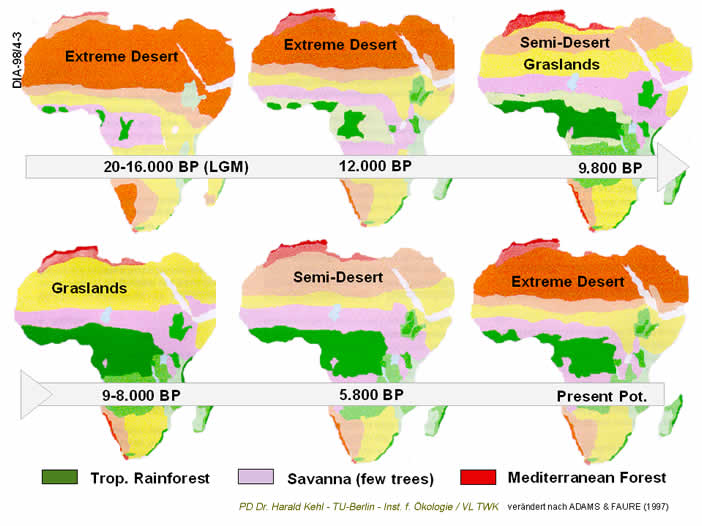Abstract:
"A set of preliminary, broad-scale vegetation map
reconstructions for use by archaeologists and anthropologists
is presented here for the world at the last glacial maximum
(18,000 years ago), the early Holocene (8000 years ago), and
the mid-Holocene (5000 years ago). For comparison we also
give “present - potential” maps which may be regarded
as approximating the late Holocene vegetation as it would
- or might - be without agricultural modification. The maps
were produced through consultation with an extensive network
of experts and a range of literature and map sources. Accompanying
each regional map is a bibliography detailing the principal
literature sources of evidence on Late Quaternary palaeovegetation
and climates. The maps presented here are not intended as
the “last word” on the distribution of vegetation
at each time slice - they are merely a preliminary attempt
at appraisal of current knowledge and opinion. Nevertheless,
together with the accompanying citation summary they should
provide a valuable and readily accessible source of information
on current opinion in the Quaternary community. It is also
hoped that the maps will themselves act as a catalyst for
archaeologists to use their own data to contribute to the
broader climatic/palaeovegetational picture."
Suggested citation format for the QEN - Quaternary
Environments
Networkpages:
Adams
J.M. & Faure H. (1997 Edit.s), QEN members.  Review
and Atlas of Palaeovegetation: Preliminary land ecosystem
maps of the world since the Last Glacial Maximum. Oak
Ridge National Laboratory, TN, USA. Review
and Atlas of Palaeovegetation: Preliminary land ecosystem
maps of the world since the Last Glacial Maximum. Oak
Ridge National Laboratory, TN, USA.
[last
date of access: 16.09.2019]
Abstract:
"The paper provides new and comparative insight into
the ecological history of the two largest continental tropical
forest areas during the Last Glacial Maximum (LGM). The tropical
forest regions are of particular interest because they present
a large source of heat and have been shown to have significant
impact on the extra tropical atmospheric circulation. They
are also the most intense land-based convective centers. Thus,
especially from the tropics paleoecological information is
needed as benchmarks for climate modeling. The African data
for LGM climates were published earlier including the reconstructed
paleoprecipitation patterns deduced from SSTs.
The
tropical South American LGM data were interpreted from pollen,
geochemical, and d18O (stable oxygen isotope) data from Brazil
and selected surrounding areas. The available terrestrial
data are consistent with the SST derived precipitation data
for the tropical forests in Brazil and for Africa. However,
the impact of LGM climate extremes was less severe in the
Amazon than in the Congo basin.
The LGM humid forest area (including evergreen and semi-deciduous
forest types) in Africa was probably reduced by 84%. In contrast,
the Amazon humid forest area probably shrank to 54% of their
present-day extension. Still,
there are different interpretations with respect to the amount
of reduction of the Amazon forest area during the LGM. Although
direct information about LGM climates in Amazonia is still
limited the more detailed map obtained in the present work,
however, allows a more reliable characterization of the last
glacial tropical environment than previously published for
the Amazon region."
|
